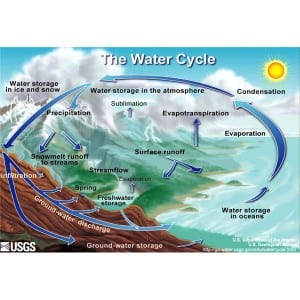Blog by Simon Damkjaer, UCL ISR PhD student
Substantial increases in the combustion of fossil fuels over the 20th Century have led to a shifting climate, whose impacts on global water resources are best experienced through changes in the global hydrological cycle. As part of a series of posts related to the 2013 UCL Energy and UCL ISR Climate Week, this blog post provides an overview of the most direct impacts of climate change on water resources and highlights my Doctoral Research on the importance of hydrological stores under a changing climate.

Ice sheets and glacier retreats
Climate change has been popularly coined “Global Warming”, and as the name itself suggests, means rising temperatures. The first way, in which rising temperatures impact global water resources is through the transfer of freshwater from a state of solid snow and ice into water as a fluid state. The ice-sheets of Greenland and Antarctica have been melting at alarming rates over the past decades [1], which has led to an increase in the mean rate of sea-level rise of 3.3 mm/year relative to a 20th Century average of 1.7 mm/year [2]. The effects of rising sea levels, simply put, will exacerbate the risk of storm surges at coastal areas.
Furthermore, snowfall over the polar ice-sheets is predicted to be reduced. This, in combination with melting ice-sheets, will decrease the ice-sheets’ albedo effect – that is the amount of surface that deflects incoming solar irradiation. A reduction in albedo effect risks triggering so-called feedback mechanisms, a system of circular loops, in which the warming of the global surface is enhanced, as less incoming heat is reflected due to a reduction in albedo which is caused by ice-sheet retreat due to rising temperatures and so forth.
Although alpine glaciers are currently melting at rates three times lower than that of ice-sheets, their impacts are still felt through effects on river flow, whose influence range from moderate in mid-latitude basins, to major influence in very dry basins. The main issue related to an increase in glacier melt rate is that it causes a mismatch and unpredictability in the timing of dry period river flows, which has implications for access to water for agricultural purposes.
Precipitation, Evaporation and Transpiration alterations
The second way in which the global water cycle is affected by a shifting climate is experienced by the ability of hotter air to hold more water, which in return affects precipitation and evaporation rates. The effects of increasing precipitation rates are felt at two extremes. At the one end, rainfall events will be more extreme, short-term and variable, which will lead to increased run-off and thus higher flood risks. At the other end, the intervals between these short-lived and heavy rainfall events, will get longer, which increases drought risks.
As temperatures rise, more water evaporates back into the air, which means less water availability for crops – “less crop per drop”. Additionally, from a biological point of view, higher CO2 levels in the atmosphere, cause terrestrial plants to transpire less, thus lowering the amount of water they use – “less drop per crop”. It, therefore, becomes evident that the impacts of climatic changes will have severe implications for food security in the future.
Uncertainty: a key challenge
The biggest challenge to the water resources community in modelling the impacts of a shifting climate on water resources is the extreme uncertainty associated with the exercise. Apart, from the general well-known processes, how these shifts will affect water’s wider environmental interconnectedness still remains unclear. In fact, the Intergovernmental Panel on Climate Change (IPCC) have taken a long time to properly include the effects of climate change on water resources into their annual reports, which is evidenced by only dedicating ten pages in their 4th Annual Report. The reason for this has not been to downplay the importance of water, whose scarcity indeed was declared the second biggest global risk at the 2013 World Economic Forum, but simply because predicting the effects of climate change on water resources, continues to prove difficult, particularly on groundwater, where data is scarce.
The importance of stores
The effects of climate change on the global hydrological cycle may appear to only lead to situations of disadvantages. However, studies from East Africa [3], which my Doctoral Research is grounded in, suggests that climatic effects in this part of the world, will cause an intensification in rainfall, which benefits groundwater recharge. As research in the domain increases, so does the realisation that our understanding of groundwater resources remain limited.
Groundwater stores will become increasingly important in the future, as they possess a slower response-time to climatic shifts than that of surface water. These resources, therefore, should be considered a key adaptation strategy to a shifting climate. However, a history of legislative neglect of the resources, means that notions and understanding of sustainable management and utilisation of groundwater stores remain in their infancy. Thus, it remains to be seen what the water the resources community has in store for the future.
[1] Rignot et al. (2011), Geophys. Res. Lett., vol. 38, L05503
[2] Nicholls and Casenave (2010), Science, vol. 328, 151 7-1520.
[3] Taylor et al. (2012) Nature Climate Change, Vol. 2, doi: 10.1038/nclimate1731
 Close
Close



